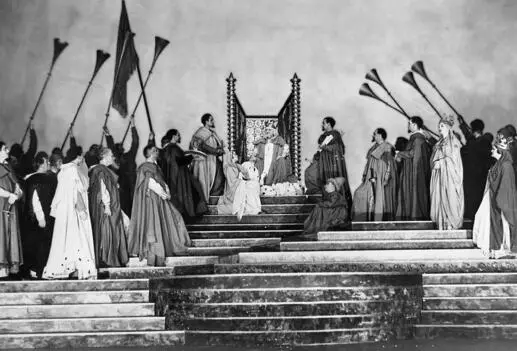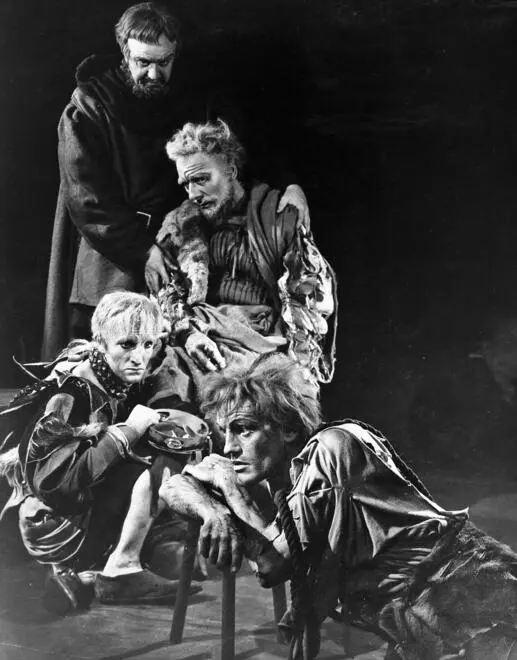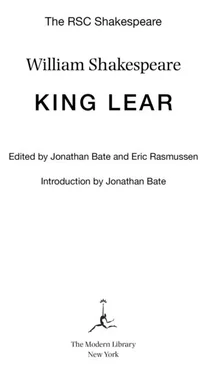уильям шекспир - King Lear
Здесь есть возможность читать онлайн «уильям шекспир - King Lear» весь текст электронной книги совершенно бесплатно (целиком полную версию без сокращений). В некоторых случаях можно слушать аудио, скачать через торрент в формате fb2 и присутствует краткое содержание. Год выпуска: 2011, ISBN: 2011, Издательство: Random House Publishing Group, Жанр: Старинная литература, на английском языке. Описание произведения, (предисловие) а так же отзывы посетителей доступны на портале библиотеки ЛибКат.
- Название:King Lear
- Автор:
- Издательство:Random House Publishing Group
- Жанр:
- Год:2011
- ISBN:978-1-58836-828-7
- Рейтинг книги:3 / 5. Голосов: 1
-
Избранное:Добавить в избранное
- Отзывы:
-
Ваша оценка:
- 60
- 1
- 2
- 3
- 4
- 5
King Lear: краткое содержание, описание и аннотация
Предлагаем к чтению аннотацию, описание, краткое содержание или предисловие (зависит от того, что написал сам автор книги «King Lear»). Если вы не нашли необходимую информацию о книге — напишите в комментариях, мы постараемся отыскать её.
King Lear — читать онлайн бесплатно полную книгу (весь текст) целиком
Ниже представлен текст книги, разбитый по страницам. Система сохранения места последней прочитанной страницы, позволяет с удобством читать онлайн бесплатно книгу «King Lear», без необходимости каждый раз заново искать на чём Вы остановились. Поставьте закладку, и сможете в любой момент перейти на страницу, на которой закончили чтение.
Интервал:
Закладка:
During the Regency period, when old King George III was mad, the London theater managers tactfully abstained from staging the play. Soon after the king’s death in 1820, the fiery Romantic actor Edmund Kean played the role at Drury Lane later to mixed reviews. The London Times objected that the storm scene “was less effective than many others” chiefly because it was “exhibited with so much accuracy that the performer could scarcely be heard amidst the confusion,” but the reviewer was better pleased by the fifth act in which “there was scarcely a dry eye in the theatre.” 5William Hazlitt felt that “Mr. Kean chipped off a bit of the character here and there: but he did not pierce the solid substance, nor move the entire mass.” 6Hazlitt reviewed Junius Brutus Booth’s production at Covent Garden in the same year more favorably: “There was no feebleness, and no vulgarity in any part of Mr. Booth’s acting, but it was animated, vigorous, and pathetic throughout.” 7
When Macready, who had played Edmund to Booth’s Lear, restored Shakespeare’s text in his Covent Garden production of 1838, the Fool, reintroduced for the first time in more than a hundred and fifty years, was played by a young woman, Priscilla Horton. Macready set the play in a pagan Saxon Britain replete with Druidic stone circles. Critics were generally enthusiastic:
Mr. Macready’s Lear, remarkable before for a masterly completeness of conception, is heightened by this introduction of the Fool to a surprising degree. It accords exactly with the view he seeks to present of Lear’s character.… Mr. Macready’s representation of the father at the end, broken down to his last despairing struggle, his heart swelling gradually upwards till it bursts in its closing sigh, completed the only perfect picture that we have of Lear since the age of Betterton. 8
It may be asked how someone writing a century and a half after the event could have known that Betterton’s was a “perfect picture” of Lear, but the point here is to stress how much the characterization of Lear gains from the restoration of his foil, the Fool.
Samuel Phelps produced the play at Sadler’s Wells in 1845 using simpler staging and a fuller version of the text than that of Macready, which had remained heavily cut despite the rejection of Tate. The naturalism of Phelps’ performance was praised but the storm was thought excessive: “It is not imitation, but realization.” 9Charles Kean staged a successful production at the Princess’s Theater in 1858. Set in Anglo-Saxon Britain, it boasted a strong supporting cast including Kate Terry as Cordelia. Meanwhile in New York, Edwin Booth, son of Junius Brutus, revived the play using Shakespeare’s text, giving a performance described by William Winter as “the fond father and the broken old man. It was the great heart, shattered by cruel unkindness, that he first, and most of all, displayed.” 10The great Italian actor Tommaso Salvini, also won praise for his performances at Boston’s Globe Theatre in 1882 and London’s Covent Garden in 1884, despite the fact that he spoke in Italian while the rest of the cast spoke in English, a proceeding that the novelist Henry James described as “grotesque, unpardonable, abominable.” 11Henry Irving’s elaborately staged production at the Lyceum in 1892 was set in a Britain of Roman ruins with Druidic priests and Viking warriors. Using a heavily cut text that reduced the play’s violence and sexuality, Irving emphasized Lear’s age and paternalism in a performance that attracted mixed notices, although Ellen Terry’s Cordelia was widely praised.
At the end of the nineteenth century directors such as William Poel and Harley Granville Barker promoted the simple staging of Shakespeare’s plays, attempting to recreate the conditions of the Elizabethan playhouse, with its fast continuous action in contrast to the spectacular staging of the Victorians, which involved lengthy scene changes. In his Prefaces to Shakespeare (1927), Granville Barker argued vigorously against critical prejudice toward the play in performance and insisted on its theatrical viability, a judgment borne out by the many productions since. The twentieth and twenty-first centuries have produced a number of distinguished Lears but have also concentrated on more balanced productions that give greater weight and opportunity to lesser roles.
John Gielgud first played Lear in Harcourt Williams’ production at the Old Vic in 1931 at the age of twenty-six. Despite his obvious talent, critics thought him too young for the part. In 1940 Gielgud had a second opportunity to play the part, again at the Old Vic, in a production set in early modern Europe, based on the ideas of Granville Barker, who oversaw the early rehearsals and personally coached Gielgud. In an essay of 1963 Gielgud claimed that the ten days in which Barker worked with the company “were the fullest in experience that I have ever had in all my years upon the stage.” 12The production was a success, although the noted critic James Agate concluded that Gielgud’s performance was “a thing of great beauty, imagination, sensitiveness, understanding, executive virtuosity, and control. You would be wrong to say—this is not King Lear! You would be right to say that this is Lear every inch but one.” 13
In 1936 the director-designer Theodore Komisarjevsky staged a memorable and radical production at the Shakespeare Memorial Theatre in Stratford-upon-Avon. There was a simple but effective set, consisting mainly of a grand staircase, illuminated by a cyclorama that changed color to reflect the mood of the scene. As the London Times review put it:

3. Expressionist design in the 1930s: the opening scene of the Komisarjevsky production.
On this simple stage of steps and platforms, where every movement is sharp and significant and the light-borne colour keeps pace with the changing character of the scene, Mr. Randle Ayrton has complete freedom to act Lear. 14
A decade later Laurence Olivier played Lear at the Old Vic as “a whimsical old tyrant who takes this way of dividing his kingdom simply as a jest, until the joke turns serious because Cordelia refuses to play.” 15His performance was not to all tastes but Alec Guinness as the Fool was widely praised. Sir Donald Wolfit, an old-style actor-manager, toured his own production between 1947 and 1953—Ronald Harwood’s experience as Wolfit’s backstage dresser inspired his play The Dresser (1980).
Gielgud played Lear for a third time in 1950, in a production which he co-directed with Anthony Quayle. Although his performance had developed in a number of ways, it was still largely influenced by his work with Granville Barker. He played the part again in 1955 in a production directed by George Devine and designed by Isamu Noguchi. This time Gielgud aimed for psychological realism in his performance but it was generally agreed that while the stylized set worked, the heavy costumes were problematic.

4. John Gielgud as Lear in the hovel (1950 production), with Fool and Poor Tom in the foreground, the disguised Kent behind.
In 1956 Orson Welles directed and starred in a production at the New York City Center. Falling and breaking one ankle and spraining the other during rehearsals, Welles, undeterred, played the part in a wheelchair, pushed around by the Fool. In 1959 Charles Laughton played Lear in a production at the Shakespeare Memorial Theatre, directed by Glen Byam Shaw. Critics were divided, especially about Laughton’s conception of the role. One of them, Alan Brien, complained that Laughton developed “from boyishness to senility without even an intervening glimpse of maturity.” 16
Читать дальшеИнтервал:
Закладка:
Похожие книги на «King Lear»
Представляем Вашему вниманию похожие книги на «King Lear» списком для выбора. Мы отобрали схожую по названию и смыслу литературу в надежде предоставить читателям больше вариантов отыскать новые, интересные, ещё непрочитанные произведения.
Обсуждение, отзывы о книге «King Lear» и просто собственные мнения читателей. Оставьте ваши комментарии, напишите, что Вы думаете о произведении, его смысле или главных героях. Укажите что конкретно понравилось, а что нет, и почему Вы так считаете.












